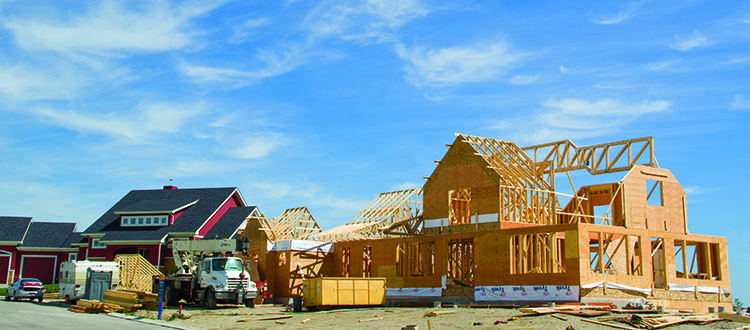
Among the major changes to building codes is an increase in the minimum run dimension on interior stairs. CREB®Now file photo
July 19, 2016 | Alex Frazer Harrison
Changing times
New building codes on the horizonThe national standards that inform provincial building codes have received their twice a decade overhaul, however some of the changes may not take effect in Alberta for a awhile.
Every five years, Codes Canada (formerly the National Model Construction Codes), under National Research Council Canada, is updated to reflect changing needs and demands in residential and building construction. The 2015 edition includes approximately 600 changes to building, fire and plumbing codes.
Among the major changes to building codes is an increase in the minimum run dimension on interior stairs (the depth of the step) from 210 mm to 254. André Laroche, manager of regulatory solutions for Codes Canada, says this increase may reduce falls by as much as 64 per cent.
"The impact (on builders) is stairs will be less steep, but they'll also be wider, meaning we'll take a bit more space to design stairs," Laroche says.
Another major change increases flexibility of decorative elements on handrails and guards placed 4.2 metres above the floor or less, Laroche says, meaning designs are no longer restricted to vertical lines to prevent climbing.
"We're now allowing any configuration for guards up to a certain height when the difference in elevation between two levels is 4.2 metres or less," he says.
Accessibility in public areas is also addressed in the new edition, with updated codes covering design standards for "accessible routes," doorways, locations of controls like light switches and washroom facilities for people with mobility challenges.
The new edition will not take effect immediately in Alberta, as the province has to review the changes (a mix of substantial and editorial) first; this is expected to take until early 2018, says James Orr, director, standards development, with Alberta Municipal Affairs.
That said, one major change to the 2015 national code that allows for six-storey wood construction was one the province saw coming, and it has already been put into force, Orr says.
Changing codes can have an impact on builders and home prices. Jayman Built, for example, is preparing to incorporate new energy code standards for Alberta that come into force in November.
"With the new energy code coming we're doing some testing (of homes) for energy performance and air-tightness," says Dave Krasman, director of corporate purchasing, noting some of the specifications are already in place in Jayman builds. "We've been using triple-pane windows for two years now and just added tankless water heaters."
Krasman notes that code changes do sometimes result in added home costs.
"If you're looking at the cost of homes, a big part of it is (incorporating) new codes and other government regulations," he says.
Orr says Alberta's Safety Codes Act has been amended to allow for faster adoption of the federal codes; the goal being to have only a one-year lag between the 2020 Codes Canada edition and adoption in Alberta.
"This will allow industry and municipalities 100 per cent certainty as to when new codes are coming in, which will be good for training, preparation and consultation," Orr says.
Tagged: accessibility | building codes | Calgary Real Estate | Calgary Real Estate News | construction | homebuilders | jayman built | Uncategorized | YYCRE




